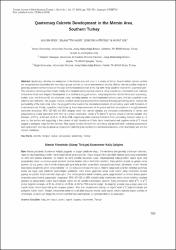| dc.contributor.author | Eren, Muhsin | |
| dc.contributor.author | Kadir, Selahattin | |
| dc.contributor.author | Hatipoglu, Zübeyde | |
| dc.contributor.author | Gül, Murat | |
| dc.date.accessioned | 2020-11-20T16:37:00Z | |
| dc.date.available | 2020-11-20T16:37:00Z | |
| dc.date.issued | 2008 | |
| dc.identifier.issn | 1300-0985 | |
| dc.identifier.uri | https://hdl.handle.net/20.500.12809/5031 | |
| dc.description | WOS: 000260966000007 | en_US |
| dc.description.abstract | Quaternary calcretes are widespread in the Mersin area and occur in a variety of forms. Several distinct calcrete profiles are recognized and subdivided into two major groups defined by mature and immature profiles. Mature calcrete profiles comprise a generally isolated calcrete horizon at the base and hard laminated crust at the top with rarely pisolithic crust in the uppermost part. The immature calcrete profiles consist mainly of an isolated calcrete horizon which is rarely overlain by a laminated crust. Calcrete forms show three main stages of development: (i) a mottled or plugged horizon, comprising isolated calcrete forms such as powdery, nodule, tube, and fracture-fill; (ii) calcareous crusts, including laminar and hard laminated calcrete crusts, and (iii) a pisolithic crust which is very restricted. The plugged horizon, in which calcite is precipitated from downward moving percolating water, reduces the permeability of the host-rocks. Later, the plugged horizon leads to the horizontal movement of percolating water with formation of a calcareous crust. Finally, a pisolithic crust forms by down-slope movement of the grains and their accumulation in troughs between dome-like structures. XRD, ICP-AES and SEM analyses show that calcrete samples are composed predominantly of calcite, and palygorskite is closely associated with them as a minor constituent. Calcite delta O-18 and delta C-13 isotope values of calcrete samples vary between -4.31 to -6.82 and -6.03 to -9.65 % PDB, respectively which indicates formation from percolating meteoric water at, or near to, the surface and supporting a thin column of soil. Abundance of beta fabric constituents and negative calcite d 13 C values suggest a pedogenic origin for the calcretes. They appear to have formed from percolating soil-derived water mainly by precipitation and replacement, and also by displacive replacement (detrital grain calcification) and biomineralization under alternating wet and dry climatic conditions. | en_US |
| dc.description.sponsorship | Scientific and Techological Research Council of Turkey (TUBITAK)Turkiye Bilimsel ve Teknolojik Arastirma Kurumu (TUBITAK) [YDABAG-102Y036] | en_US |
| dc.description.sponsorship | This study was financially supported by the Scientific and Techological Research Council of Turkey (TUBITAK) under the Project of YDABAG-102Y036. Therefore, the authors are grateful to TUBITAK for its support. We thank Professor Dr. Maurice E. Tucker and anonymous reviewer of the journal for their constructive reviews. Chris Herron and Steve Mittewede edited English of the text. Thanks are also due to John D. A. Piper for his kind help in polishing the English of the final text. | en_US |
| dc.item-language.iso | eng | en_US |
| dc.publisher | Scientific Technical Research Council Turkey-Tubitak | en_US |
| dc.item-rights | info:eu-repo/semantics/openAccess | en_US |
| dc.subject | calcrete | en_US |
| dc.subject | hardpan | en_US |
| dc.subject | nodule | en_US |
| dc.subject | pedogenesis | en_US |
| dc.subject | Quaternary | en_US |
| dc.subject | Turkey | en_US |
| dc.title | Quaternary Calcrete Development in the Mersin Area, Southern Turkey | en_US |
| dc.item-title.alternative | Mersin Yöresinde (Güney Türkiye) Kuvaterner Kaliş Gelişimi | |
| dc.item-type | article | en_US |
| dc.contributor.department | MÜ, Mühendislik Fakültesi, Jeoloji Mühendisliği Bölümü | en_US |
| dc.contributor.institutionauthor | Gül, Murat | |
| dc.identifier.volume | 17 | en_US |
| dc.identifier.issue | 4 | en_US |
| dc.identifier.startpage | 763 | en_US |
| dc.identifier.endpage | 784 | en_US |
| dc.relation.journal | Turkish Journal of Earth Sciences | en_US |
| dc.relation.publicationcategory | Makale - Uluslararası Hakemli Dergi - Kurum Öğretim Elemanı | en_US |


















